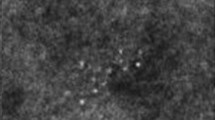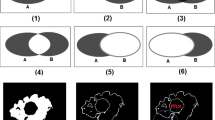Abstract
In this paper, we propose a new image registration technique using two kinds of information known as object shapes and voxel intensities. The proposed approach consists of two registration steps. First, an initial registration is carried out for two volume images by applying Procrustes analysis theory to the two sets of 3D feature points representing object shapes. During this first stage, a volume image is segmented by using a geometric deformable model. Then, 3D feature points are extracted from the boundary of a segmented object. We conduct an initial registration by applying Procrustes analysis theory with two sets of 3D feature points. Second, a fine registration is followed by using a new measure based on the entropy of conditional probabilities. Here, to achieve the final registration, we define a modified conditional entropy (MCE) computed from the joint histograms for voxel intensities of two given volume images. By using a two step registration method, we can improve the registration precision. To evaluate the performance of the proposed registration method, we conduct various experiments for our method as well as existing methods based on the mutual information (MI) and maximum likelihood (ML) criteria. We evaluate the precision of MI, ML and MCE-based measurements by comparing their registration traces obtained from magnetic resonance (MR) images and transformed computed tomography (CT) images with respect to x-translation and rotation. The experimental results show that our method has great potential for the registration of a variety of medical images.









Similar content being viewed by others
References
Hajnal, J. V., Hill, D. L. G., & Hawkes, D. J. (2001). Medical image registration. New York: CRC Press.
Maintz, J. B. A., & Viergever, M. A. (1998). A survey of medical image registration. Medical Image Analysis, 2(1), 1–36.
Sonka, M., & Fitzpatrick, J. M. (2000). Handbook of medical imaging, vol. 2. Medical image processing and analysis. Washington: SPIE Press.
Yoo, T. S. (2004). Insight into images: Principles and practice for segmentation, registration, and image analysis. Massachusetts: A K Peters.
Fitzpatrick, J. M., & West, J. B. (2001). The distribution of target registration error in Regid-Body point based registration. IEEE Transactions on Medical Imaging, 20(9), 917–927.
Chan, H. M., & Chung, A. C. S. (2003). Efficient 3D–3D vascular registration based on multiple orthogonal 2D projections. LNCS, 2717, 301–310.
Mases, F., Collignon, A., Vandermeulen, D., Marchal, G., & Suetens, P. (1997). Multimodality image registration by maximization of mutual information. IEEE Transaction on Medical Imaging, 16(2), 187–198.
Mases, F., Vandermeulen, D., & Suetens, P. (2003). Medical image registration using mutual information. Proceedings of The IEEE, 91(10), 1699–1722.
Periaswamy, S., & Farid, H. (2003). Elastic registration in the presence of intensity variations. IEEE Transactions on Medical Imaging, 22(7), 865–874.
Pluim, J. P. W., Maintz, J. B. A., & Viergever, M. A. (2003). Mutual information based registration of medical images: A survey. IEEE Transactions on Medical Imaging, 20, 1–20.
Wirth, M. A., Narhan, J., & Gray, D. (2002). Non-rigid mammogram registration using mutual information. SPIE Medical Imaging: Image Processing, 4684, 562–573.
Lee, H., & Hong, H. (2005). Robust surface registration using a Gaussian weighted distance map in PET-CT brain images. CAIRP 2005, LNCS 3773 (pp. 794–803).
Liu, T., Shen, D., & Davatzikos, C. (2004). Deformable registration of cortical structures via hybrid volumetric and surface warping. NeuroImage, 22, 1790–1801.
Moradi, M., Abolmaesoumi, P., & Mousavi, P. (2006). Deformable registration using scale space keypoints. Proceedings of SPIE, 6144, 791–798.
Pluim, J. P. W., Maintz, J. B. A., & Viergever, M. A. (2000). Image registration by maximization of combined mutual information and gradient information. IEEE Transactions on Medical Imaging, 19(8), 809–814.
Johnson, H. J., & Christensen, G. E. (2002). Consistent landmark and intensity-based image registration. IEEE Transactions on Medical Imaging, 21(5), 450–461.
Gan, R., & Chung, A. C. S. (2005). Distance-intensity for image registration. LNCS, 3765, 281–290.
Dryden, I. L., & Mardia, K. V. (1998). Statistical shape analysis. New York: Wiley.
Zhuang, H., & Sudhaker, R. (1997). Simultaneous rotation and translation fitting of two 3-D point sets. IEEE Transactions On Systems, Mam, And Cybernetics, 27(1), 127–131.
Wen, G., Wang, Z., Xia, S., & Zhu, D. (2006). Least-squares fitting of multiple M-dimensional points sets. Visual Computation, 22, 387–398.
Caselles, V., Kimmel, R., & Sapiro, G. (1995). Geodesic active contours. In Proceedings of ICCV, 95, 694–699.
Cho, W., Kim, S., Lee, M., & Park, S. (2007). Extraction of anatomic structures from medical volumetric images. MMM 2007, LNCS 4351, Part 1 (pp. 86–95).
Han, X., Xu, C., & Prince, J. L. (2003). A topology preserving level set method for geometric deformable models. IEEE Transanctions on PAMI, 25(6), 755–768.
Osher, S., & Nikos Paragios, (2006). Geometric level set methods in imaging, vision, and graphics. Springer.
Osher, S., & Sethian, J. A. (1988). Fronts propagating with curvature dependent speed: Algorithms based on Hamilton–Jacobi formulations. J. Computational Physics, 79, 12–49.
Sethian, J. A. (2005). Level set methods and fast marching methods. Cambridge University Press.
Vese, L. A., & Chan, T. F. (2002). A multiphase level set framework for image segmentation using the Mumford and Shah model. International Journal of Computer Vision, 50, 271–293.
Kelland, P., & Tait, P. G. (2005). Introduction to quaternions. Adamant Media Corporation.
Zhu, Y. M., & Cochoff, S. M. (2002). Likelihood maximization approach to image registration. IEEE Transactions on Image Processing, 11(12), 1417–1426.
Ibanez, L., Schroeder, W., Ng, L., & Cates, J. The ITK software Guide. Kitware.
Acknowledgement
This work was supported by the Korea Research Foundation Grant funded by the Korea government (KRF-2007-311-D00752).
Author information
Authors and Affiliations
Corresponding author
Appendix
Appendix
Result 3.1 The full Procrustes fit gives us the matching parameters which are the translation parameter and the rotation parameter. They are
Proof: We wish to minimize over (u 0, v 0, w 0, θ) the expression
where A and B are centered. Clearly, the minimizing the square distance yields that u 0, v 0 and w 0 are zero. Let \(\left( {{\mathbf{A}}^ * } \right)^T {\mathbf{B}} = re^{i_H \omega } \left( {r \geqslant 0} \right)\) and then we have
So to minimize the square distance D 2 over θ we need to maximize 2rcos(θ + ω). Clearly, a solution for θ is \(\ifmmode\expandafter\hat\else\expandafter\^\fi{\theta } = - \omega = - \arg {\left( {{\left( {A^{*} } \right)}^{T} B} \right)}\).
Rights and permissions
About this article
Cite this article
Cho, WH., Kim, SW., Lee, ME. et al. Multimodality Image Registration Using Spatial Procrustes Analysis and Modified Conditional Entropy. J Sign Process Syst Sign Image Video Technol 54, 101–114 (2009). https://doi.org/10.1007/s11265-008-0203-9
Received:
Revised:
Accepted:
Published:
Issue Date:
DOI: https://doi.org/10.1007/s11265-008-0203-9




